I grew loads of peppers in my garden this year just so I could make this fermented hot sauce recipe. It is wonderfully spicy and big on flavor. Drizzle it over anything. Works for any type of peppers.
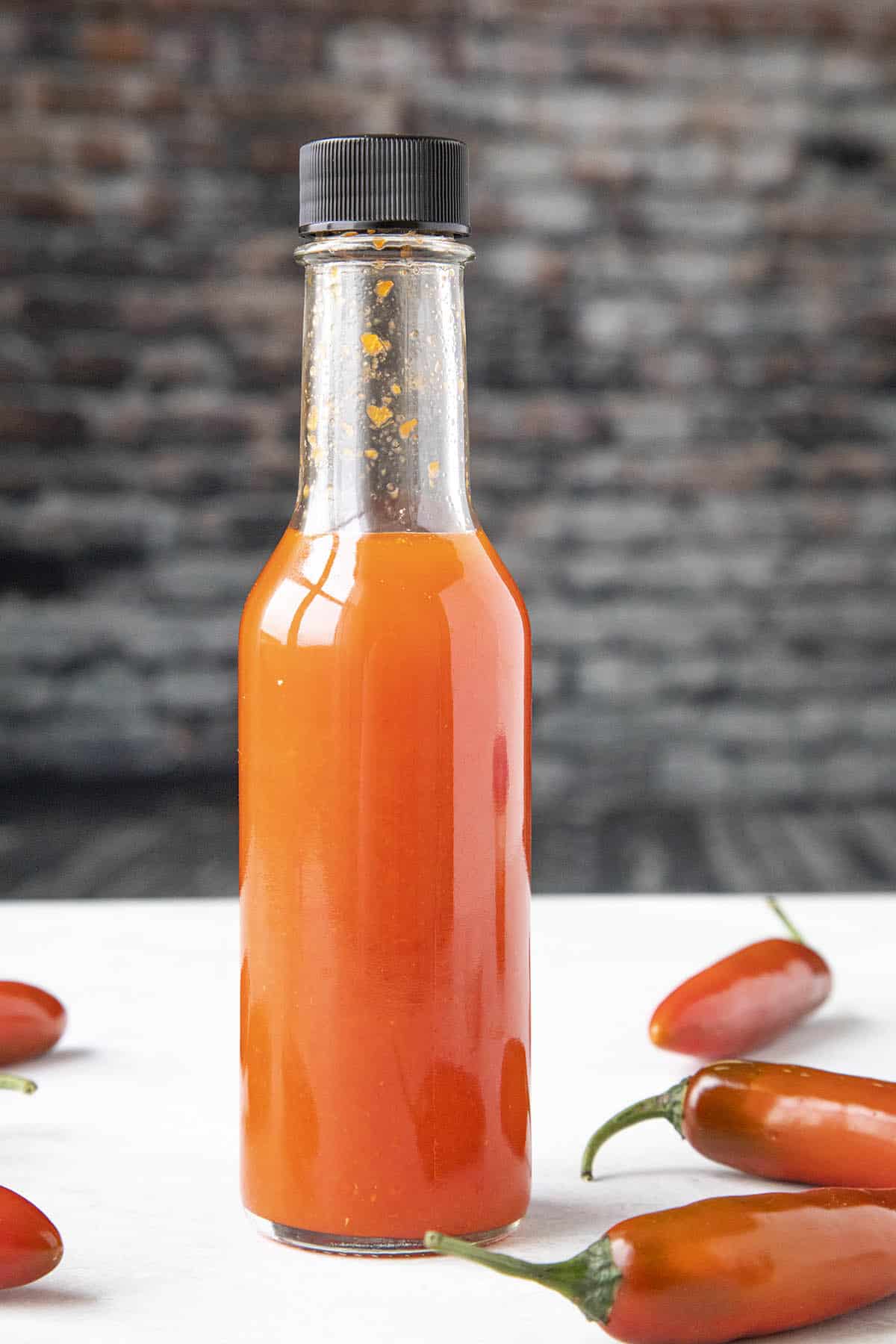
Fermented Hot Sauce Recipe
It's hot sauce making time in the Chili Pepper Madness household again, my friends. You know how much I LOVE my hot sauce. My garden exploded with peppers this year and I'm incredibly happy.
The plants were super productive and I am preserving them in so many different ways.
Food preservation is important. One of my favorite ways to preserve my peppers is to make hot sauce. I have a LOT of different hot sauce recipes here on the site, all with different styles, ingredients, and types of chili peppers.
For this particular hot sauce, I wanted a fermented version, which adds another layer of complexity to the sauce.
I grew serrano peppers and waited for them to turn red specifically so I could make this sauce. So many serranos! The plant was very productive.
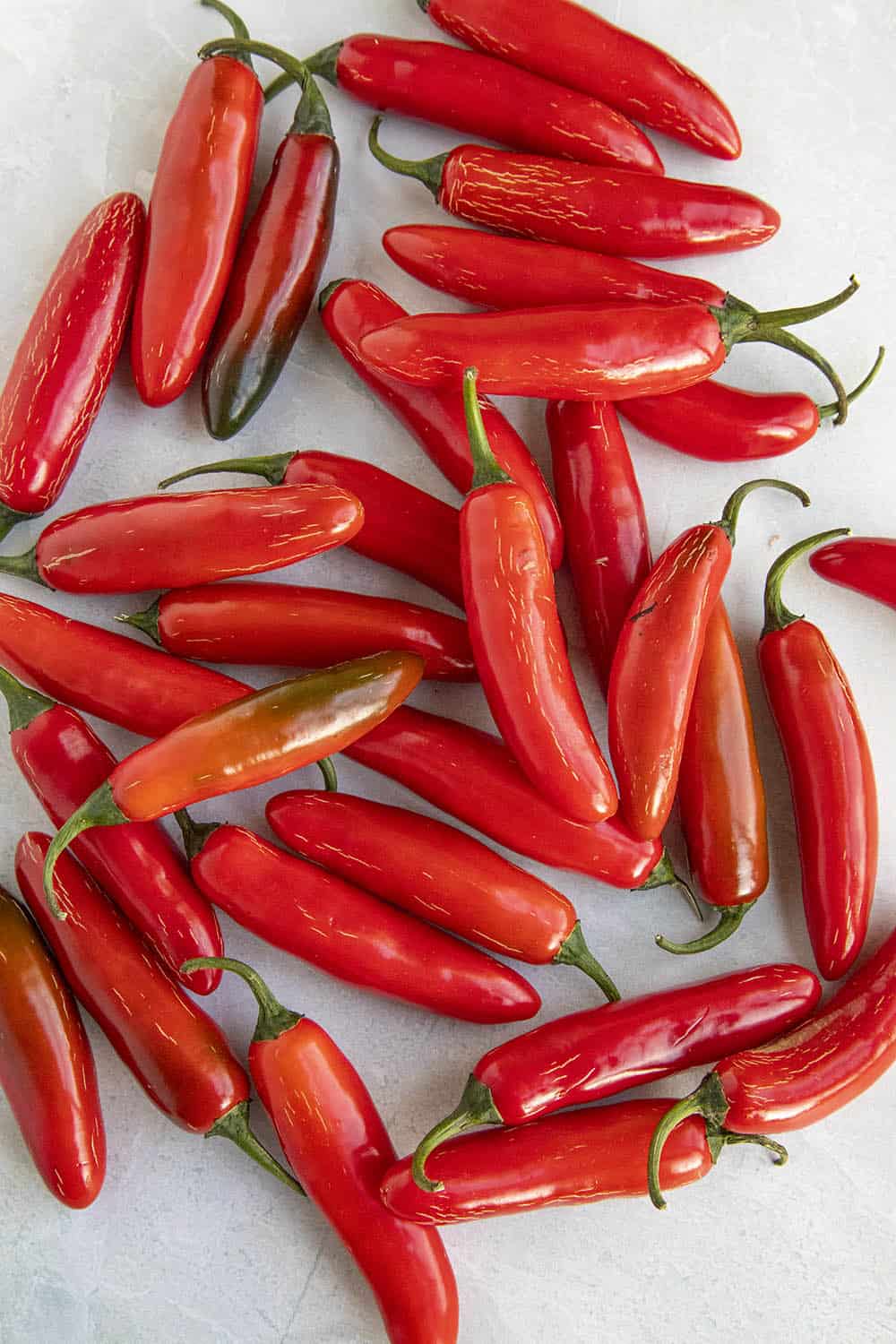
I just love serrano peppers. They're smaller than jalapeno peppers, but quite a bit hotter. In fact, the hottest serrano pepper is about 3 times hotter than the hottest jalapeno pepper.
They measure in at 10,000 to 23,000 Scoville Heat Units on the Scoville Scale. For me, that's a nice level of heat for an every day hot sauce.
You don't have to use serranos, though. This recipe works with any type of chili pepper.
This is a very simple hot sauce recipe, though we're fermenting the peppers first, which may sound complicated, but not at all.
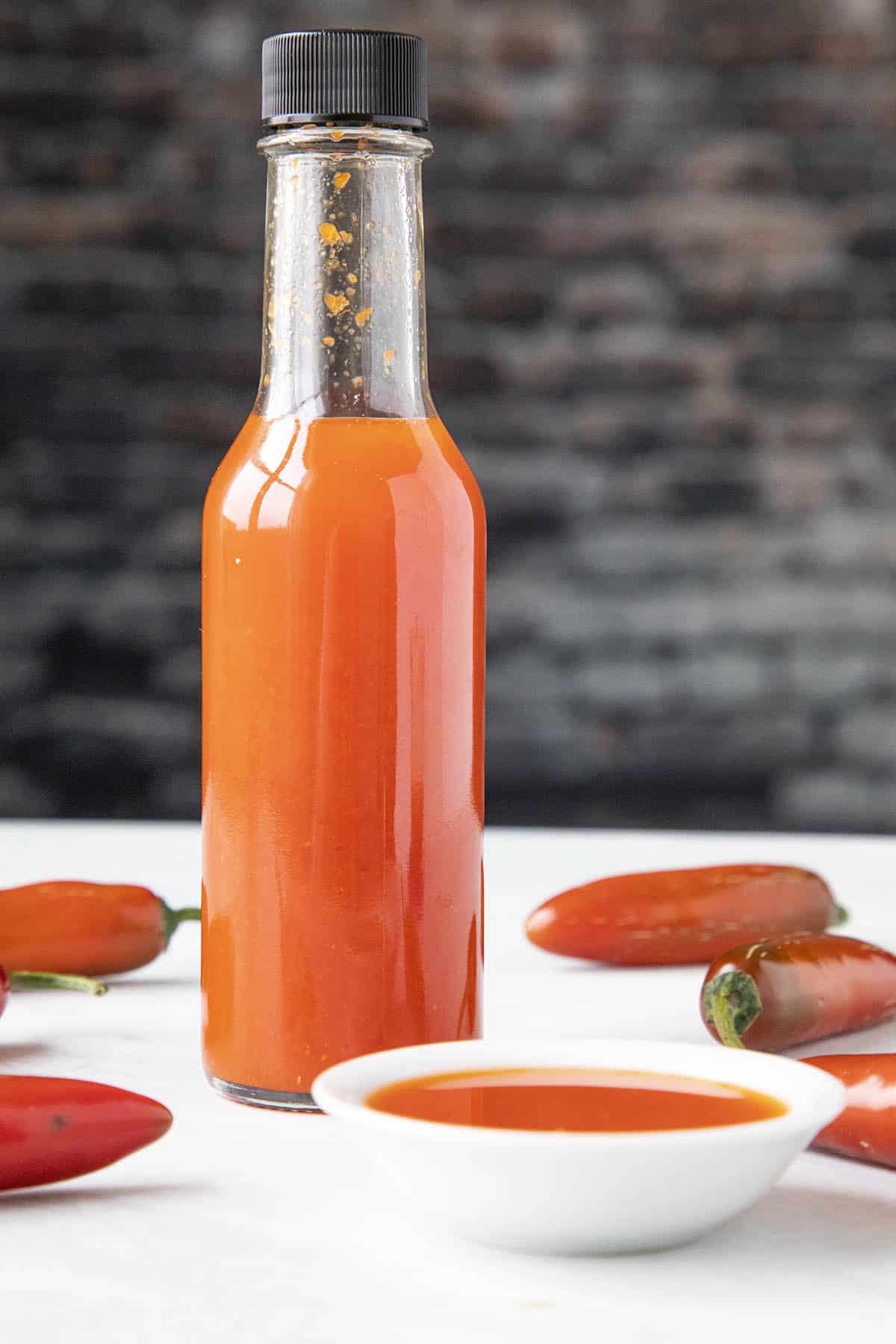
What is Fermentation? And Why is it Good For Hot Sauce?
Fermentation is the decomposition of foods by micro-organisms (Lactic Acid Bacteria) or enzymes. We create an anaerobic (no oxygen) environment for the peppers so that good, beneficial bacteria can survive, and bad bacteria cannot survive.
The good bacteria is natural Lactic acid bacteria, which consumes carbohydrates in the peppers and converts them to acid. After fermenting, the carbohydrates have been predigested, leaving them with more vitamins and flavor than fresh peppers.
Bad bacteria, such as rotting molds, cannot survive in this oxygen-free environment. We create such an environment with salt and brine, which protect the peppers while the good bacteria do their work.
The salt is not actually the preservative. It is the acid produced by the fermentation process that does the preserving.
There are many benefits to fermented foods, including foods that are more digestible and have more developed flavor. When fermenting peppers, the flavors mellow, and peppers change color a bit, and develop a pleasant smell.
Fermentation is one our oldest methods of food preservation. People have preserved foods this way for generations, from wine to cheese to many, many vegetables, including peppers.
Let's talk about how to make a simple fermented hot sauce, shall we? Here is my recipe for fermented hot sauce.
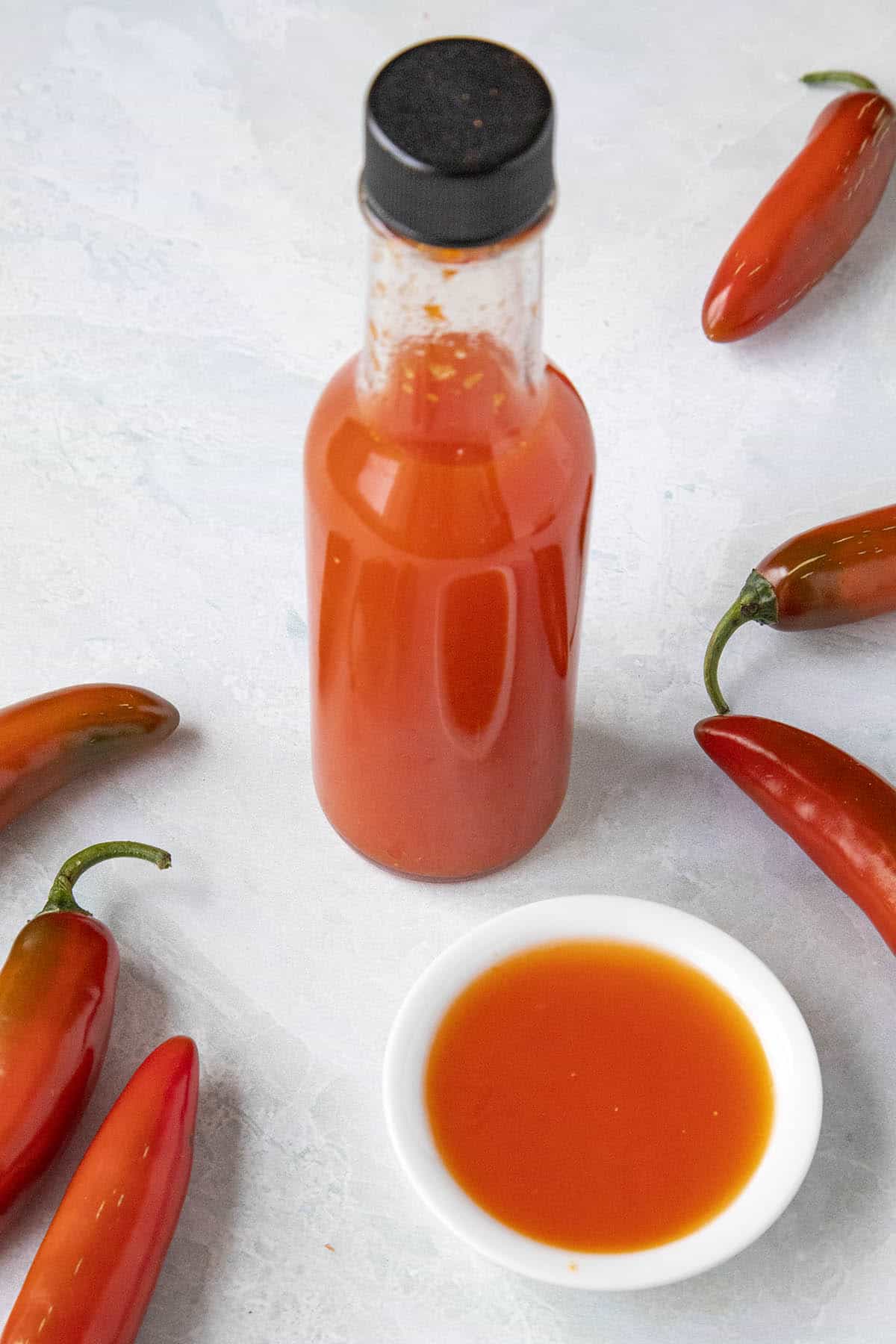
Ingredients Needed to Make Fermented Hot Sauce
- 1 pound chili peppers (stems removed - I'm using red serrano peppers)
- 1 quart unchlorinated water
- 3 tablespoons salt
- ½-1 cup white wine vinegar to your preference (use a good quality vinegar for better quality hot sauce)
How to Make Fermented Hot Sauce - the Recipe Method
First, ferment the chili peppers. Roughly chop the peppers, then pack them into a ball jar, leaving at least 1 inch of head space. The peppers may rise a bit when fermenting.
Mason jars are good to use as fermentation vessels as well.
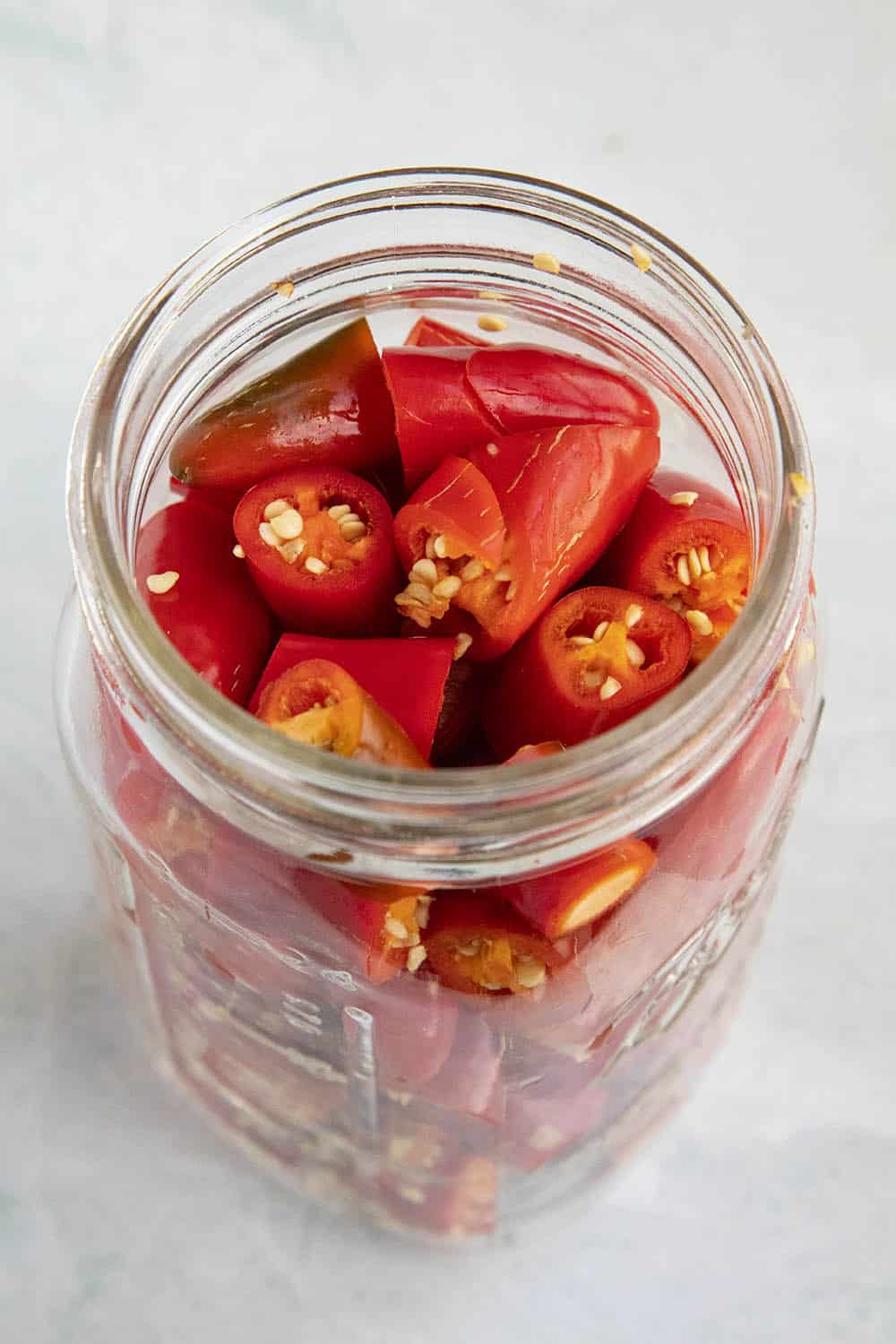
Make the Brine. Next, mix 1 quart unchlorinated water with 3 tablespoons sea salt. Pour just enough brine over the peppers to cover them, pressing them down a bit as you go.
It is important to keep the peppers covered with the salt water brine to avoid spoilage. Check this daily.
HELPFUL TIP: A good method to keep the peppers submerged is to fill a baggie with some water, but not all the way. Stuff the baggie into the top of the jar, forcing the peppers down below the brine.
Screw on the lid and set the jar away from direct sunlight to ferment for at least 1 week. Ideal temperatures are between 55-75 degrees F.
The most active fermentation period is between 1-2 weeks, so be sure to monitor it during this time. “Burp” the jars often by unscrewing the lid a bit to let out some of the accumulating gases.
Or, use an airlock or membrane for easier fermenting. See our page, “How to Ferment Peppers”, for more detailed instruction.
After 1-2 weeks, the fermenting activity will diminish and the brine will turn cloudy and taste acidic, with a slightly sour flavor.
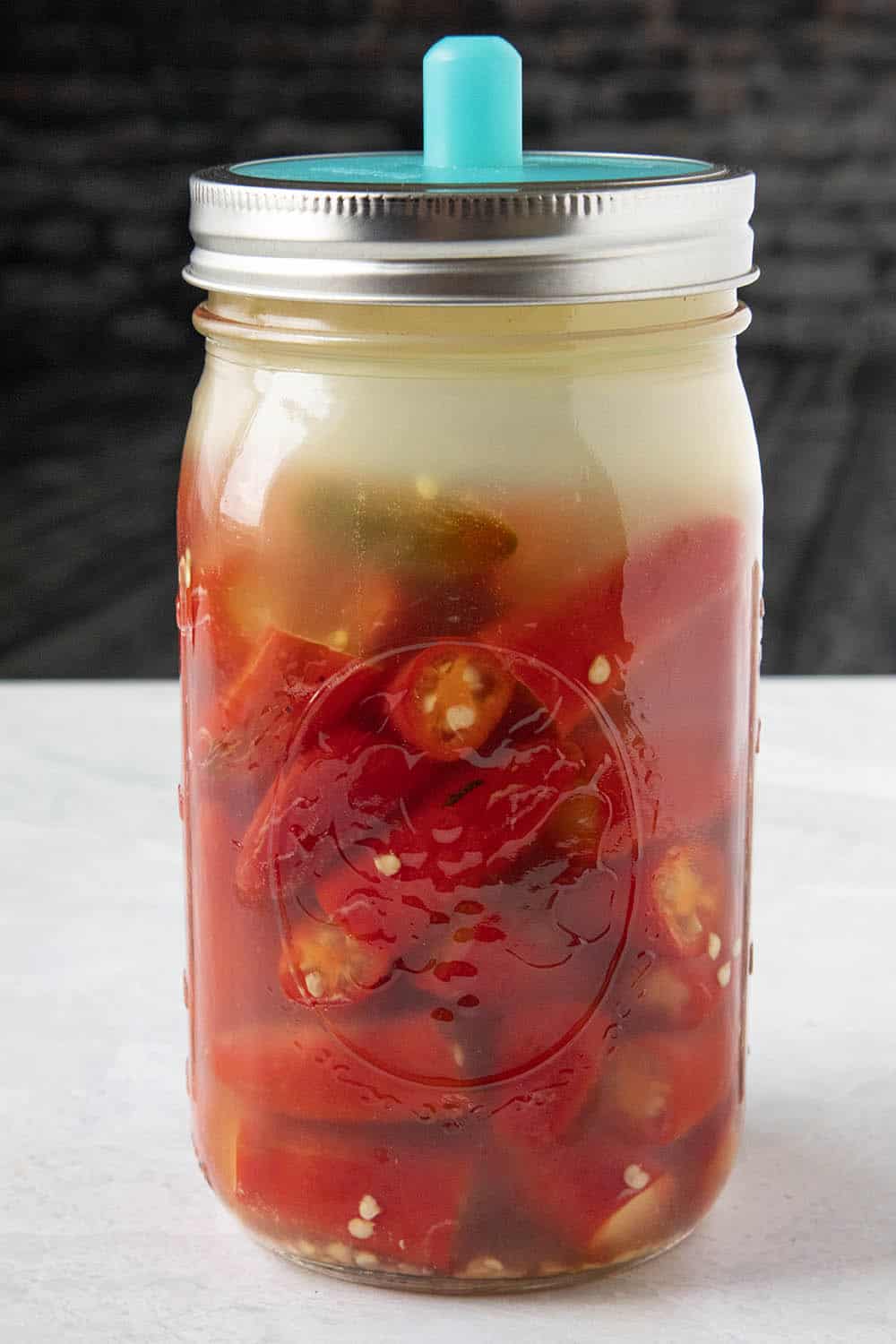
Drain the peppers, but reserve the brine.
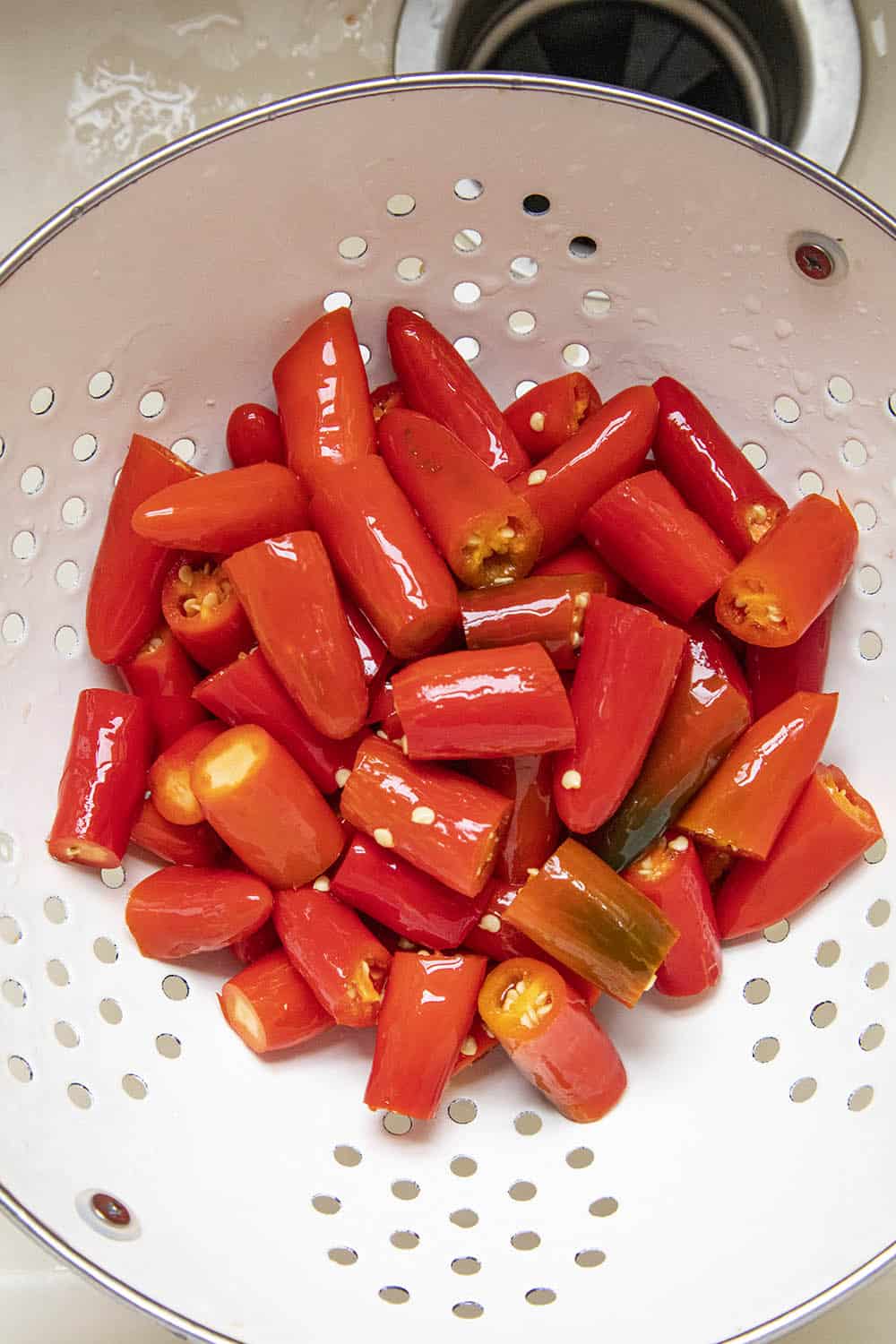
Add the fermented peppers to a food processor or blender, along with 1/2 cup of the brine and 1/2 cup vinegar.
You can add more or less of each as desired to your preference. More brine will have more salty flavor, more vinegar will be more acidic.
Blend until smooth.
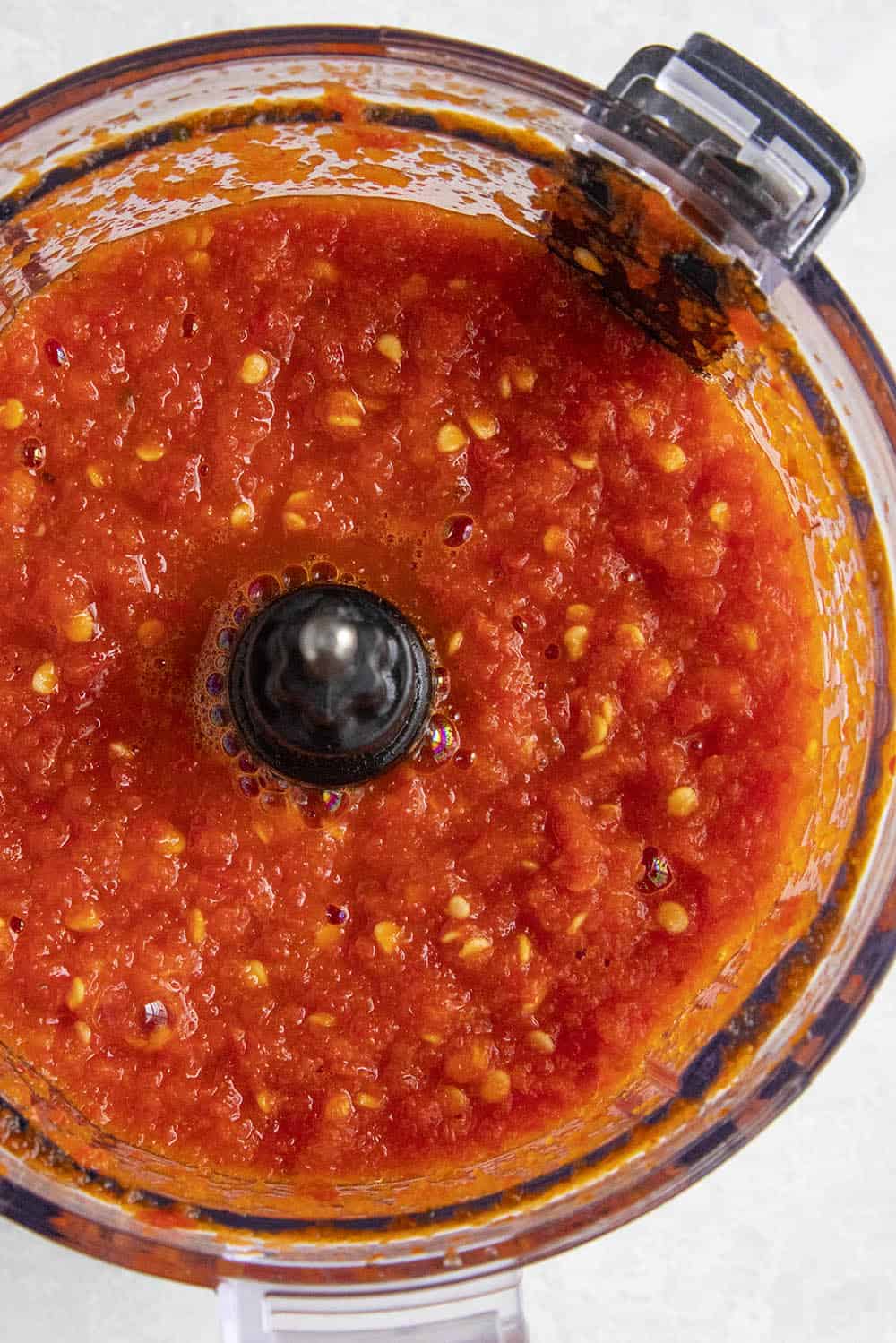
OPTIONAL: Add the fermented hot sauce to a pot and bring to a quick boil. Reduce heat and simmer for 15 minutes. This will stop the fermentation process.
NOTE: You don't have to cook the sauce if you don't want to. Cooking removed the probiotic benefits. It can be used as-is, though you will likely see some continued fermenting activity. If you decide to not cook it, store it in the refrigerator in sealed containers.
You may need to burp them to release gas buildup every now and then, though refrigeration will slow the activity.
Strain the mixture to remove the solids if desired, or use as-is for a thicker hot sauce. Pour into hot sauce bottles and enjoy.
That's it, my friends! Easy, right? Who knew making a fermented hot sauce could be so simple? It's really quite a bit like famous Tabasco Hot Sauce, though made with red serrano peppers instead of tabasco peppers.
Recipe Tips & Notes
Fermentation Time. Feel free to ferment longer if you'd like. Continuing to ferment the peppers will develop even more flavor. I have fermented peppers for 6 months in the past.
Some people ferment for years. 1 week, however, is enough to get a good ferment.
Kahm Yeast. Sometimes you may notice a white film forming on the top of your ferment. It is sour and can form when all of the sugar in your ferment is consumed.
It is not a mold, nor is it harmful. It can affect the flavor of your finished hot sauce, so it is best to be scraped away from your ferment.
Thicker or Thinner Hot Sauce. If you're looking for a thicker hot sauce, only use a combined half cup of brine and vinegar, and do not strain the hot sauce.
For a thinner hot sauce, add more water and/or vinegar a bit at a time until you achieve the consistency you want.
Straining the hot sauce will thin it out considerably.
Other Ingredients. This is a very simple Louisiana Style Hot Sauce recipe, using only peppers, vinegar and salt.
You can easily include other ingredients to build flavor, such as garlic, onion, herbs and other seasonings.
Other Peppers. This method works with any type of chili peppers. Try it with a blend of hot peppers and/or mild peppers.
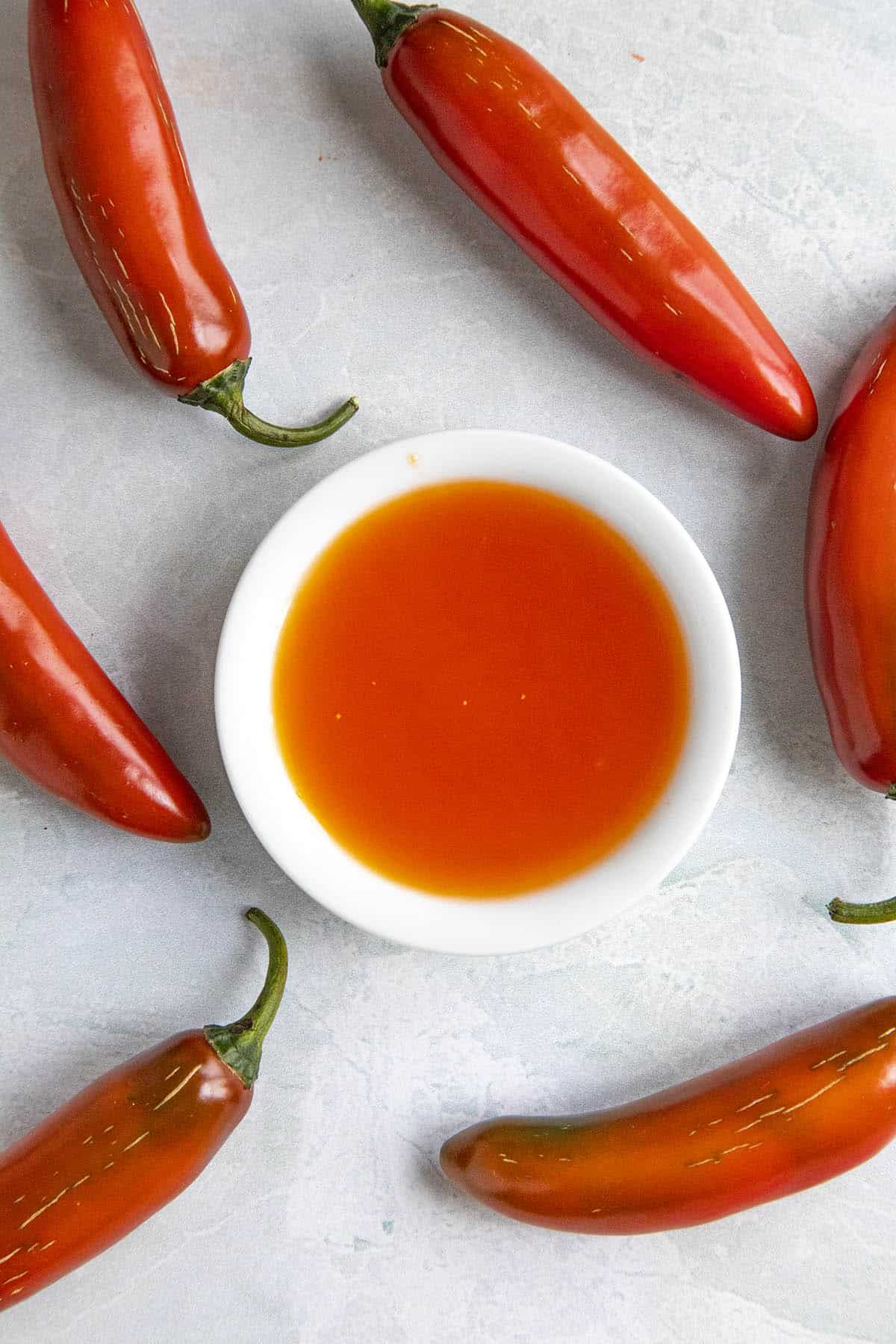
Frequently Asked Hot Sauce Questions
Here are answers to some of the most common questions I get on other hot sauces.
How long will this sauce keep?
Fermented hot sauce will keep for many months in the refrigerator, or even longer. It's all about the acidity.
To be technical, target level ph for shelf stable foods is below 4.6 ph, but should probably be lower for home cooks, around 3.5 or so, to account for errors.
If you're concerned, add more vinegar to lower the ph. I measured the pH of my finished fermented hot sauce at 3.7, but check with a good pH meter.
The best ph meters that I recommend are from Thermoworks. Get yourself a ph meter from Thermoworks today. I am a happy affiliate.
Fermented hot sauces that are not cooked at the end with vinegar and/or citrus should be refrigerated.
Cooking them stops the fermentation activity and makes them more shelf stable, though they are no longer probiotic.
Where'd you get that sauce bottle?
I find them locally sometimes, but I also order through Amazon. Here is a link to some bottles I like (affiliate link, my friends!): Swing Top Glass Bottles, 8.5 Ounce - Set of 4.
If you like the smaller bottles that most hot sauce makers use, here's another link: Hot Sauce Bottles, 5 Oz - 24 Pack.
Can I process this hot sauce for longer storage?
Absolutely. Just be sure to use proper canning/jarring safety procedures. Processing the hot sauce in a water bath stops the bacterial activity, making the hot sauce shelf-stable.
However, it will no longer be probiotic. The National Center for Home Food Preservation provides home canning instructions and many recipes that have been tested for food safety. NCHFP.uga.edu.
Useful Equipment
Aside from jars and your ingredients, I like to use Masontops lids, which include pickling weights and a membrane allowing gases to escape without the need for burping.
You can use them with any wide mouth mason jar. Here is a link to where you can buy them on Amazon. It’s an affiliate link, my friends. FYI!
Buy Masontop Lids for Fermenting Chili Peppers (and More)
I also highly recommend this outstanding book by fermenting experts, Kirsten K. Shockey and Christopher Shockey – “Fiery Ferments: 70 Stimulating Recipes for Hot Sauces, Spicy Chutneys, Kimchis with Kick and Other Blazing Fermented Condiments”. I learned a lot from this book as well as through my own experimentation. Grab a copy today.
Good luck, and happy fermenting! Let me know what you make with your pepper mash.
Try Some of My Other Fermented Hot Sauce Recipes
Here are some of my own recipes that use fermented chili peppers.
- Homemade Sriracha Hot Sauce
- Fermented Aji-Garlic Hot Sauce
- Homemade Louisiana Hot Sauce
- Homemade Tabasco Sauce
- Spicy Serrano Hot Sauce
Check out more Hot Sauce Recipes or learn more about How to Make Hot Sauce.
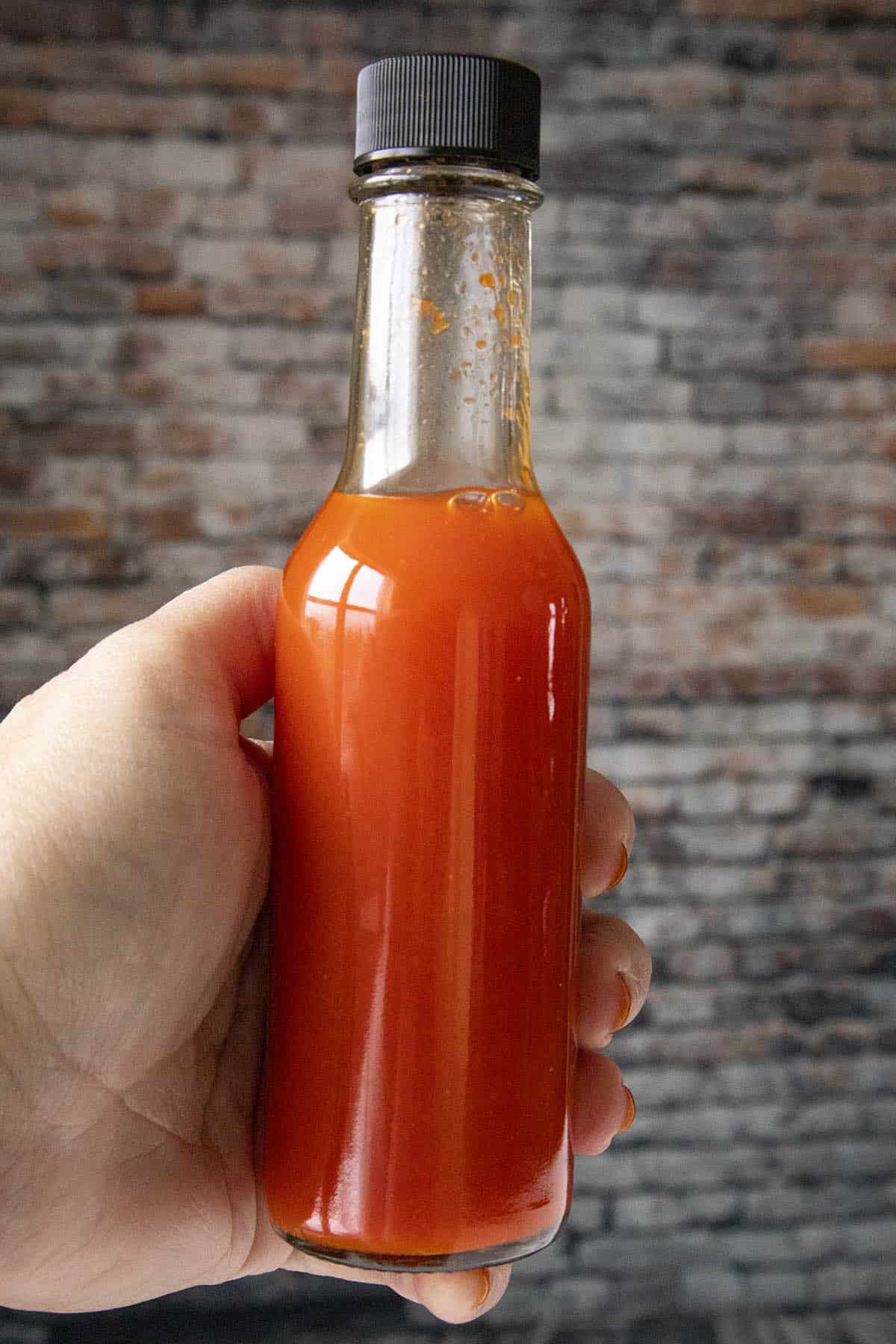
Got any questions? Ask away! I’m happy to help. If you enjoy this recipe, I hope you’ll leave a comment with some STARS. Also, please share it on social media. Don’t forget to tag us at #ChiliPepperMadness. I’ll be sure to share! Thanks! — Mike H.
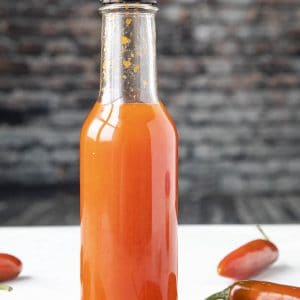
Fermented Hot Sauce Recipe
Ingredients
- 1 pound red serrano peppers or use any chili peppers, stems removed
- 1 quart unchlorinated water
- 3 tablespoons sea salt (do not use iodized salt)
- ½-1 cup white wine vinegar to your preference use a good quality vinegar for better quality hot sauce
Instructions
- First, ferment the serrano peppers. Roughly chop the peppers, then pack them into a ball jar, leaving at least 1 inch of head space. The peppers may rise a bit when fermenting.
- Next, mix 1 quart unchlorinated water with 3 tablespoons sea salt. Pour just enough brine over the peppers to cover them, pressing them down a bit as you go. It is important to keep the peppers covered with brine to avoid spoilage. Check this daily.
- Screw on the lid and set the jar away from direct sunlight to ferment for at least 1 week. Ideal temperatures are between 55-75 degrees F. The most active fermentation period is between 1-2 weeks, so be sure to monitor it during this time. “Burp” the jars often by unscrewing the lid a bit to let out some of the accumulating gases. Or, use an airlock or membrane for easier fermenting. See our page, “How to Ferment Peppers”, for more detailed instruction.
- After 1-2 weeks, the fermenting activity will diminish and the brine will turn cloudy and taste acidic.
- Drain the peppers, but reserve the brine.
- Add the fermented peppers to a food processor or blender, along with 1/2 cup of the brine and 1/2 cup vinegar. You can add more or less of each as desired to your preference. More brine will have more salty flavor, more vinegar will be more acidic.
- Process until smooth.
- Optional Step. Add the fermented hot sauce to a pot and bring to a quick boil. Reduce heat and simmer for 15 minutes. This will stop the fermentation process and meld the flavors, but will remove the probiotic benefits.
- Strain the mixture to remove the solids if desired, or use as-is for a thicker hot sauce. Pour into hot sauce bottles and enjoy.
- You can add more vinegar or water to thin out the hot sauce.
Notes
Nutrition Information


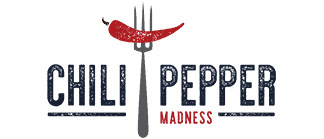


Rob C. says
Is there a product that can be bought to keep the fermentation temperatures in the sweet spot? I think a fridge would be too cold and my house room temperature will be at the limit of too warm. Haven’t tried my first batch yet, so can’t give a rating yet.
Mike Hultquist says
Rob, I believe there are electric fermentation pots that keep a constant temp, though I've never used one. They might be more for things like yogurt, black garlic, etc. I usually just keep the jars in my pantry, which is darker and a touch cooler, though I don't keep our home very warm.
Steve says
Hi there, thanks for the recipe. I was wondering if I could substitute some lime juice for some of the vinegar to add some lime flavor? Do you think it would be a one to one substitution? I like to ferment my peppers in a vac sealed bag. Makes thing easy 2.5% salt by weight vac sealed for two weeks. Thanks again for the recipe.
Mike Hultquist says
Steve, yes, you can use lime juice or citrus instead. You can use a total sub or a mix. It's really a flavor preference. You really don't need vinegar at all with fermented hot sauce, as it's already quite acidic from the fermenting process.
Mike M. says
Hi! Love the recipe and all the tips! I’m currently about a week in on the fermentation. I’ve been burping the jars twice a day but I’ve lost some liquid when doing so and I’m afraid if I lose more the peppers won’t be fully submerged. Is it best to add new baggies filled with more water or add more brining solution?
Mike Hultquist says
Mike, if you can avoid adding anything, that is best. However, it is super important to keep the peppers below the brine, so yes, you can add a new baggie to push them down. Just be sure it is VERY clean. You can also pour in a touch more brine. Let me know how it goes!
Carl John says
Hi Mike, This is will be my third attempt at making your hot sauce. The first time wasn't so great as white a substance, I supposed mold developed after a few days. Left it on kitchen counter in a very warm climate, maybe the reason. The second time was so much better as i kept it in the fridge the following day after making it. Family and visitors was entused by its taste.
Thank you.
Mike H. says
You are very welcome, Carl. Glad to hear about the second try - enjoy!
Darnell says
First let me say I love your recipes. my question, I have left over fermented hot sauce. Can I add it to a new batch I want to ferment?
Mike Hultquist says
Thanks, Darnell. Yes, you can add more peppers to keep the ferment going. Enjoy!!
Harry says
Hi Mike,
I have some red Habaneros fermenting at the moment. Would these alone be overkill for this type of sauce ? I can handle the heat of a Tobasco/Franks style sauce fine but am concerned the red Habs are just going to be way too much, especially bearing in mind how versatile the big branded sauces are.
Does fermenting and cooking dull the intensity somewhat? I guess there's only one way to find out ?
Mike Hultquist says
Hi, Harry. You can make a hot sauce with habaneros alone. I have a recipe on the site for that. Yep, it's pretty hot, hotter than Tabasco. If you're concerned, definitely mix them with milder peppers to balance out the heat. Fermenting mellows it a bit, gives a bit of funk factor. Cooking mellows them a bit, but really both develop the flavors, making them less vegetal than raw. I hope you like it overall! Enjoy!
Harry says
Thankyou for your response Mike. Will take this all on board. As I have a whole pound of Habs fermenting, could I mix say half a pound of bell peppers in when making the sauce if I really want to bring the spice level down for this particular recipe? Or maybe a quarter of a pound ?
Mike Hultquist says
Equal amounts of bells and habs will still give you a good level of heat, but with the additional flavor of the bells. You might try an equal split, but note the flavor and heat level so you can adjust for the next time. You can also make smaller batches of different amounts, even add different ingredients to some to have multiple hot sauces. Let me know how it turns out for you.
Pizzle says
Is there ganerally a ratio you use of brine and vinegar as a base.?
Like percentage brine and vinegar to peppers or brine and vinegar to peppers/vegetables/fruit?
Mike Hultquist says
Pizzle, it's really more to preference of flavor and thickness of the sauce. I like a bit more vinegar flavor to my hot sauces sometimes, so it can vary from batch to batch.
Ben says
This is great! I have tons of hot peppers to make it. Question, some books say to put the peppers in blender and mash up first them pour the mash into jar for the fermentation process. Why do they want you to do this instead of just putting the chopped pepper into jar with the brine?
Mike Hultquist says
Thanks, Ben. You can definitely do that. You can fit much more of the peppers/mash in the jar if you process them. Only issue you might run into is keeping it all below the brine. Otherwise, it's a great method. Enjoy!
Andrijana Kelevra says
Can you add ACV instead of white wine vinegar?
Mike Hultquist says
You surely can, yes!
Jonathan Rodwell says
Hi Mike
I was wondering if I can use whisky instead of Vinegar in the fermented hot sauce?
Mike Hultquist says
Jonathan, yes, you can make hot sauces with whisky or other booze. I believe I have one on the site, as well as with some BBQ sauces.
ADRIAAN says
Hello mike, I have been juicing my chillis and fermenting the juice by just adding salt. I leave it for around 10 days and it seems to be ok is there anything you can advise me on about this process. I like to dehydrate the pulp to make chilly powder.
Mike H. says
Hi Adriaan, 10 days is a decent fermenting time! Just make sure you're using the right amount of salt to keep things safe and tasty. When fermenting, keep an eye out for any signs of mold or off odors. As for dehydrating the pulp for chili powder, that's a great way to minimize waste and amp up the flavor in other dishes. Just make sure it's thoroughly dried before grinding to powder to prevent any moisture-related spoilage. Enjoy the process and come back for more recipes! 😉
ADRIAAN says
THANKS MIKE, I APPRECIATE YOUR KNOWLEDGE.
Jim says
When fermenting peppers and other ingredients, can a small amount of oil be ok? I want to caramelize some ingredients, but that requires a small amount of oil or butter. I have been reading varying opinions on it and there doesn't seem to be a clear answer.
Mike Hultquist says
Jim, I don't believe you should ferment with oil, but charring, grilling, smoking, or otherwise cooking the peppers first isn't really an issue. You might try roasting them on a non-stick surface to avoid oils in the ferment, but I don't believe a tiny amount from other forms of cooking would really affect it. I haven't done it that way, though. You might need a starter if doing it this way, or mix the cooked with fresh chilies if needed to start fermentation. Let me know how it goes for you.